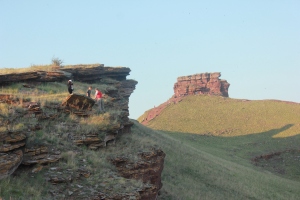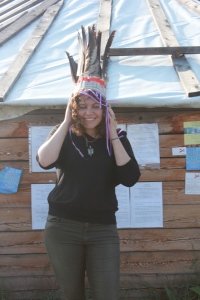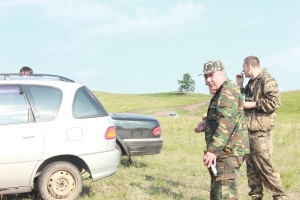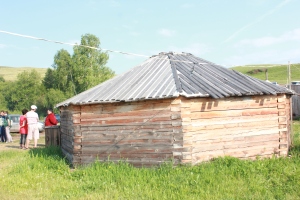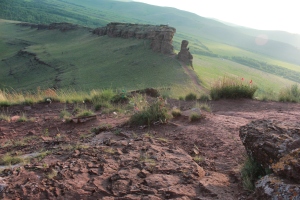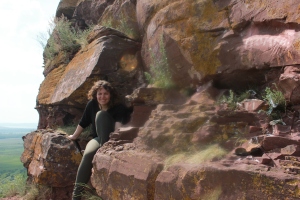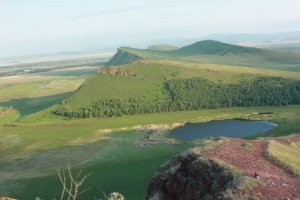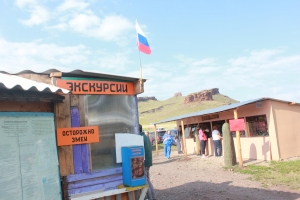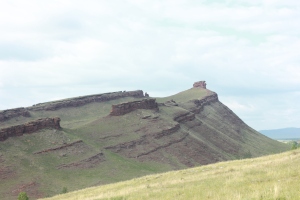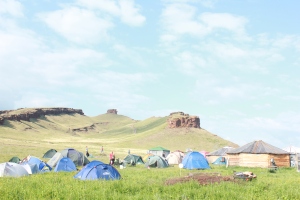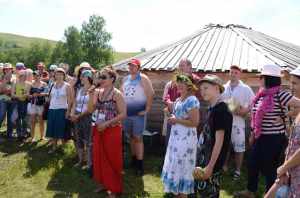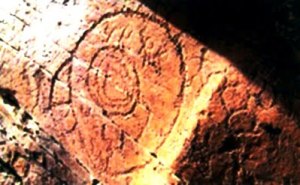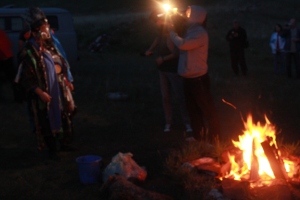A trip to the mysterious Sunduki mountain ridge—Siberia’s Stonehenge
Many westerners have been to Stonehenge in England, but not many have had the opportunity to see Sunduki, Siberia’s оwn аncient astronomical observatory and, according to local shamans, one of the holiest places in Siberia. The Sunduki are five sandstone mounts that rise majestically from the steppe in Shikinsky District of Khakassia. Each wave-like mountain topped with peculiarly shaped rock formations, many of that resemble boxes. It is for this reason that locals named this place Sunduki, which means “chests” in Russian. Historians, shamans, geologists, and archeologists might disagree when discussing the origins of the Sunduki. Despite their divergent views, they all will agree that Sunduki is a mystical place that provides insight into the history of Khakassia. Many, especially the local Khakas shamans and ethnographers, perceive the sunduki both literally and figuratively. Those petrified chests on top of the mounts symbolize the source of ancient Khakas wisdom, which is why many Khakas people regard the Sunduki mounts as a temple, a natural shrine to their ancestors.
I went to Sunduki on June 22nd to see the summer solstice. On this date, people from all over Khakassia and Southern Krasnoyarsk come to the town of Shira to spend the night at the Sunduki Museum. I was having a drink with my friend Ruslan, lamenting the fact that my time living in the center of Siberia was almost over, when I got invited to go to Siberia’s Stonehenge. Aside from being the drummer of one Abakan’s most popular rock bands, Ruslan is also journalist at a local news channel called Yiug-Sibiri. He is also working on side-project: a documentary about the most amazing, mystical places in Khakassia. Despite the fact that it was late and we were drinking, Ruslan was heading off to Sunduki in the morning to film one of the chapter of his documentary, as well as a news reportage about the Summer Solstice festival at Sunduki. Lucky for me, there was an extra seat in the car.
After stopping at the supermarket for manly necessities such as canned meat and beer, we headed off to our camping trip at Sunduki. The drive was three hours, but the beauty of the Khakassian landscape made it all go by fast… despite the fact that our tire ripped apart on our way there. The driver took out a small tire from under the car, which Russians humorously refer to as the “banana.” That banana miraculously drove us over the jagged dirt road that led to our destination. Various types of flies and mosquitoes invaded our cars as drove along the river that flows in front of the Sunduki mountain ridge. When I finally saw the Sunduki for the first time all I could do is stare in wonder. These low, smooth mountains looked like immense, petrified waves in the middle of an endless, flat expanse, crowned by well-shaped rock formations. Each sunduk (there are five of them in total) is organized according to ordinal number. The first sunduk is easy to identify because of the cubical rock structure leaning out from the top of the mountain. The first sunduk is the most spectacular mount, known as the “mountain of the world” by Vitaly Larichev, a noted astro-anthropologist from Novosibirsk who dedicated most of his career to the study of the Sunduki mountains. The rock formation, aside from being particularly chest-like, is thought to be the center of the world’s oldest astronomical observatory. The first sunduk has a canyon between the two hills that lead to the box-like rock formation. Along this canyon there are various shrines and astronomical observatories that were used for observing the rising and the setting of the sun.
The people camping at the Sunduki were also a sight. Because of censorship and stifling cultural atmosphere of the Soviet Union, I thought that Russia had never developed a hippie generation. It turns out that soviet baby boomers do exist and they all like to hang out here in the middle of Siberia. Not everyone here was a soviet hippie, though. Whether it is and archeologists with a scientific bent, a neo-shamanist, or just a person with an affinity for the esoteric, the mystique and the peculiar energy of the Sunduki mountains attracts people from different spheres of knowledge. Many were camping out on the grounds of the Sunduki Museum- Reserve, which was founded in honor on Vitaly Larichev. The museum was holding a festival called “Health and Harmony Festival at the Cathedral of the Sun—Sunduki” as a celebration of the summer solstice. The celebration started on June 20 and extended until the 22nd, the longest day of the year. Just like the summer solstice celebration at the Stonehenge site in Wittshire, England, people stay up all night to meet the sunrise. The great chest rock on the top of the first sunduk mark the rising of the sun. This festival included a wide range of attractions such as group yoga sessions, an artisan’s fair, a shaman ritual, traditional Khakas music, even firewalking. According to the administrator of the museum, Andrey Vaygandt, the energy of the Sunduki can empower people; it releases human beings’ hidden potential.
While Ruslan looked around for people to interview and worked out filming logistics with his cameraman, I roamed around the festival, looking for something to do. I decided to go horseback riding. It had been a long time since I rode a horse by myself but, since nobody seemed to have any objections, I went ahead and mounted my black horse and rode out into the mountains. The horse was lazily walked around the grounds of the museum, unsure of where I wanted to go. He turned obediently every time I slightly tugged the rein to any direction. He seemed pretty laid back. Everything was going fine until the horse freaked out when it heard the primal screams and guttural sounds coming from group of people gathered around a scaffold. It was later when I found out that they were “liberating their chakras.” Startled by the screams, the horse trotted away from camp and led me into a swampy area around the side of the mountain. The horse was transfixed with joy when he chopped down on the rich, bright green grasses of the swamp and didn’t seem like he wanted to keep walking. Meanwhile I was trying to figure out how I was going to take the horse back to the camping site. Luckily the owner found us. He asked me “what the fuck I was doing” in his finest Russian, tied a rope around the horse’s neck, and led us back to camp.
I went to see an exhibition dedicated to the late Professor Vitaly Larichev, who belonged to the Institute of Archaeology and Ethnography at the Siberian Branch of the Russian Academy of Sciences. Larichev stumbled upon the Sunduki site when he was on one of his expeditions in the 1970’s. During that time the mountains were surrounded by a large, swamp that made them inaccessible by foot, car, or horse. Larichev was immediately captivated by what seemed to be a couple of pyramids stranded on the steppe. When finally got the chance to explore the rock formations up close, he found ancient petroglyphs daing back to the Tagar culture. From that moment, Larichev decided would dedicate his career to unraveling the mysteries of the Sunduki.
Larichev posited that the Sunduki Mountains are the oldest astronomical observatory in the world, used by stargazers 16,000 years ago. Rather using standing stones, ancient Siberians used the landscape to mark the position of the sun and keep track of the coming going of the seasons. According to Professor Larichev, ancient stargazers would stand on a marker and follow the passage of the sun and moon using the “chest” of the Sunduki. In his article, “Sunduki—The Temple of Eternal Time,” Larichev explains how the position of the rock chests is ideal for stargazing.
From there (the first sunduk) you can the line of the distant horizon for ten kilometres in all directions—this is the ideal circumstance for accurate astronomical observations.
Hidden within the canyons and the crests of the first sunduk, there are various shrines and astronomical observatories. One of the most famous markers is the Dragon Stone, which at first is not very visible. When the sun sets, it lowers itself into this stone. This event is referred to as the “killing of the dragon.” For a brief, fleeting moment you can see the bright, shimmery light of the sun flooding a small crevice of the rock that is supposed to depict the dragon’s mouth. According to Larichev and many other anthropologists, this event used to mark the end of the day for the ancient inhabitants of the Sunduki flood plain. As you climb up to the immense rock chest at the summit of the first sunduk, you can see other impressive rock formations, such as the “shaman’s armchair,” which resemble a large throne overlooking the vast expanse of the steppe. Also, as you climb, you can hear the herds of sheep bleating in unison from far way. From the mountain, they look like minuscule dots huddling together.
Those who take the time to explore the canyons and numerous nooks of the Sunduki mountain ridge, might encounter rare, ancient petroglyphs that date back to the Tagar culture. The white horse, which can be seen on Black Mountain, not too far away from the first sunduk, is one of the most notable petroglyphs. Larichev posited that the drawing is 16,000 years old. This drawing of a horse, according to Larichev, is goes beyond a hunting narrative—it a symbol that represents the new season. The white horse heralds the coming of the solstice.
Another drawing, which depicts in egg with a nucleus, is an allegory of the creation of the world. As an ancient legend goes, a holy bird laid an egg, which served as a foundation for the universe. In his article “Sunduk—The Cathedral of Eternal Time, ”Larichev provides a thorough interpretation of the egg. The rings surrounding the nucleus represent the sky, the surrounding space (the egg white) is the sea, and the yolk in the center represents the Mountain of the World, or the first sunduk.
Above: The Reincarnation of the Universe
Later that evening, I witnessed my first sacrifice at a shaman ritual. The shaman priestess chanted while some men dressed in camo slaughter a perfectly healthy sheep, skinned it, and took out all of its insides. All of the animal’s parts were thrown into the fire as an offering to nature. Тhe shaman said that this sacrifice is not in vain. Through this sacrifice we celebrate and show our out appreciation for the world and our ancestors.Watching all that meat burn meaninglessly in the fire,however,made me think of the delicious kebab I could have been eating.
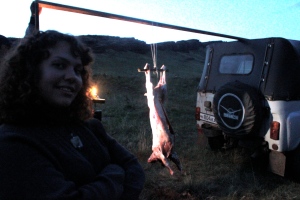
This is probably the creepiest picture I’ve uploaded into the internet, but hey! it’s what happened.
Unfortunately, I was not able to stay up to see the sunrise. My tent ended up being more comfortable than what I expected it to be, so I overslept. Being in Sunduki and going camping with a bunch of ultra-protective, beer providing men were magical experiences in themselves.
